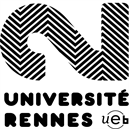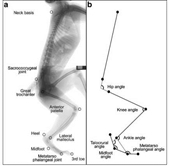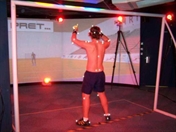

Franck Multon
Professor University Rennes 2 - Inria
2010

Using virtual reality to analyze sports performance. B Bideau, R Kulpa, N Vignais, S Brault, F Multon, C Craig. Computer graphics and applications, IEEE 30 (2), 14-21
Understanding and increasing performance in sports is difficult as many different biomechanical, physiological and psychological factors come into play during competition. To understand and consequently improve performance it is important to isolate contributing factors to determine their role in player performance. Video playback, the oft chosen method for studying this, does not permit this type of in-depth analysis. For example, the lack of control an observer has over what and how they see something is a major flaw. The aim of this paper is to present the interest of serious games and interactive immersive virtual reality (VR) as the new preferred method for understanding sports performance from a behavioral neuroscience perspective. By showcasing two practical examples which use VR and sophisticated animation software we aim to demonstrate how this technology can help us understand how the information picked up from the visual displays informs a player's future course of action.
Understanding and increasing performance in sports is difficult as many different biomechanical, physiological and psychological factors come into play during competition. To understand and consequently improve performance it is important to isolate contributing factors to determine their role in player performance. Video playback, the oft chosen method for studying this, does not permit this type of in-depth analysis. For example, the lack of control an observer has over what and how they see something is a major flaw. The aim of this paper is to present the interest of serious games and interactive immersive virtual reality (VR) as the new preferred method for understanding sports performance from a behavioral neuroscience perspective. By showcasing two practical examples which use VR and sophisticated animation software we aim to demonstrate how this technology can help us understand how the information picked up from the visual displays informs a player's future course of action.

Bipedal versus quadrupedal hind limb and foot kinematics in a captive sample of Papio anubis: setup and preliminary results. G Berillon, G Daver, K D’Août, G Nicolas, B De La Villetanet, F Multon, ... International journal of primatology 31 (2), 159-180
Setups that integrate both kinematics and morpho-functional investigations of a single sample constitute recent developmentsin the study of non human primate bipedalisms. We introduce the integrated setup built at the Primatology Station of the French National Centre for Scientific Research (CNRS), which allows analysis of both bipedal and quadrupedal locomotion in a population of 55–60 captive olive baboons. As a first comparison, we present the hind limb kinematics of both locomotor modalities in 10 individuals, focusing on the stance phase. The main results are: 1) differences in bipedal and quadrupedal kinematics at the hip, knee, and foot levels; 2) a variety of foot contacts to the ground, mainly of semiplantigrade type, but also of plantigrade type; 3) equal variations between bipedal and quadrupedal foot angles; 4) the kinematics of the foot joints act in coordinated and stereotyped manners, but are triggered differently
according to whether the support is bipedal or quadrupedal. Although very occasionally realized, the bipedal walk of olive baboon appears to be a habitual and nonerratic locomotor modality.
Setups that integrate both kinematics and morpho-functional investigations of a single sample constitute recent developmentsin the study of non human primate bipedalisms. We introduce the integrated setup built at the Primatology Station of the French National Centre for Scientific Research (CNRS), which allows analysis of both bipedal and quadrupedal locomotion in a population of 55–60 captive olive baboons. As a first comparison, we present the hind limb kinematics of both locomotor modalities in 10 individuals, focusing on the stance phase. The main results are: 1) differences in bipedal and quadrupedal kinematics at the hip, knee, and foot levels; 2) a variety of foot contacts to the ground, mainly of semiplantigrade type, but also of plantigrade type; 3) equal variations between bipedal and quadrupedal foot angles; 4) the kinematics of the foot joints act in coordinated and stereotyped manners, but are triggered differently
according to whether the support is bipedal or quadrupedal. Although very occasionally realized, the bipedal walk of olive baboon appears to be a habitual and nonerratic locomotor modality.
Influence of the graphical levels of detail of a virtual thrower on the perception of the movement. N Vignais, R Kulpa, C Craig, S Brault, F Multon, B Bideau. Presence: Teleoperators and Virtual Environments 19 (3), 243-252
Virtual reality has a number of advantages for analyzing sports interactions such as the standardization of experimental conditions, stereos copic vision and complete control of animated humanoid movement. Nevertheless, in order to be useful for sports applications, accurate perception of simulated movement in the virtual sports environment is essential. This perception depends on parameters of the synthetic character such as the number of degrees of freedom of its skeleton or the levels of detail (LOD) of its graphical representation. This study focuses on the influence of this latter parameter on the perception of the movement. In order to evaluate it, this study analyzes the judgments of immersed handball goalkeepers that play against a graphically modified virtual thrower. Five graphical representations of the throwing action were defined: a textured reference level (L0), a non-textured level (L1), a wire-frame level (L2), a moving point light display (MLD) level with a normal-sized ball (L3) and a MLD level where the ball is represented by a point of light (L4). The results show that judgments made by goalkeepers in the L4 condition are significantly less accurate than in all the other conditions (p<0.001). This finding means that the goalkeepers’ perception of the movement is influenced more by the size of the ball during the judgment task than the graphical LOD of the throwing action. The MLD representation of the movement thus appears to be sufficient for a sports duel analysis in virtual environments.
Virtual reality has a number of advantages for analyzing sports interactions such as the standardization of experimental conditions, stereos copic vision and complete control of animated humanoid movement. Nevertheless, in order to be useful for sports applications, accurate perception of simulated movement in the virtual sports environment is essential. This perception depends on parameters of the synthetic character such as the number of degrees of freedom of its skeleton or the levels of detail (LOD) of its graphical representation. This study focuses on the influence of this latter parameter on the perception of the movement. In order to evaluate it, this study analyzes the judgments of immersed handball goalkeepers that play against a graphically modified virtual thrower. Five graphical representations of the throwing action were defined: a textured reference level (L0), a non-textured level (L1), a wire-frame level (L2), a moving point light display (MLD) level with a normal-sized ball (L3) and a MLD level where the ball is represented by a point of light (L4). The results show that judgments made by goalkeepers in the L4 condition are significantly less accurate than in all the other conditions (p<0.001). This finding means that the goalkeepers’ perception of the movement is influenced more by the size of the ball during the judgment task than the graphical LOD of the throwing action. The MLD representation of the movement thus appears to be sufficient for a sports duel analysis in virtual environments.

Responsive action generation by physically-based motion retrieval and adaptation. X Liang, L Hoyet, W Geng, F Multon. Motion in Games, 313-324
Responsive motion generation of avatars who have physical interactions with their environment is a key issue in VR and video games. We present a performance-driven avatar control interface with physically-based motion retrieval. When the interaction between the user-controlled avatar and its environment is going to happen, the avatar has to select the motion clip that satisfies both kinematic and dynamic constraints. A two-steps process is proposed. Firstly, it selects a set of candidate motions according to the performance of the user. Secondly, these candidate motions are further ranked according to their capability to satisfy dynamic constraints such as balance and comfort. The motion associated with the highest score is finally adapted in order to accurately satisfy the kinematic constraints imposed by the virtual world. The experimental results show that it can efficiently control the avatar with an intuitive performance-based interface based on few motion sensors.
Responsive motion generation of avatars who have physical interactions with their environment is a key issue in VR and video games. We present a performance-driven avatar control interface with physically-based motion retrieval. When the interaction between the user-controlled avatar and its environment is going to happen, the avatar has to select the motion clip that satisfies both kinematic and dynamic constraints. A two-steps process is proposed. Firstly, it selects a set of candidate motions according to the performance of the user. Secondly, these candidate motions are further ranked according to their capability to satisfy dynamic constraints such as balance and comfort. The motion associated with the highest score is finally adapted in order to accurately satisfy the kinematic constraints imposed by the virtual world. The experimental results show that it can efficiently control the avatar with an intuitive performance-based interface based on few motion sensors.


Perception based real-time dynamic adaptation of human motions. L Hoyet, F Multon, T Komura, A Lecuyer. Motion in Games, 266-277
This paper presents a new real-time method for dynamics-based animation of virtual characters. It is based on rough physical approximations that lead to natural-looking and physically realistic human motions. The first part of this work consists in evaluating the relevant parameters of natural motions performed by people subject to various external perturbations. According to this pilot study, we have defined a method that is able to adapt in real-time the motion of a virtual character in order to satisfy kinematic and dynamic constraints, such as pushing, pulling and carrying objects with more or less mass. This method relies on laws provided by experimental studies that enable us to avoid using complex mechanical models and thus save computation time. One of the most important assumption consists in decoupling the pose of character and the timing of the motion. Thanks to this method, it is possible to animate up to 15 characters at 60Hz while dealing with complex kinematic and dynamic constraints.
This paper presents a new real-time method for dynamics-based animation of virtual characters. It is based on rough physical approximations that lead to natural-looking and physically realistic human motions. The first part of this work consists in evaluating the relevant parameters of natural motions performed by people subject to various external perturbations. According to this pilot study, we have defined a method that is able to adapt in real-time the motion of a virtual character in order to satisfy kinematic and dynamic constraints, such as pushing, pulling and carrying objects with more or less mass. This method relies on laws provided by experimental studies that enable us to avoid using complex mechanical models and thus save computation time. One of the most important assumption consists in decoupling the pose of character and the timing of the motion. Thanks to this method, it is possible to animate up to 15 characters at 60Hz while dealing with complex kinematic and dynamic constraints.

Can We Distinguish Biological Motions of Virtual Humans? Biomechanical and Perceptual Studies With Captured Motions of Weight Lifting. L Hoyet, F Multon, T Komura, A Lécuyer. Symposium on Virtual Reality Software and Technology (VRST 2010)
Perception of biological motions is a key issue in order to evaluate the quality and the credibility of motions of virtual humans. This paper presents a perceptual study to evaluate if human beings are able to accurately distinguish differences in natural lifting motions with various masses in virtual environments (VE), which is not the case. However, they reached very close levels of accuracy when watching to computer animations compared to videos. Still, quotes of participants suggest that the discrimination process is easier in videos of real motions which included muscles contractions, more
degrees of freedom, etc. These results can be used to help animators to design efficient physically-based animations
Perception of biological motions is a key issue in order to evaluate the quality and the credibility of motions of virtual humans. This paper presents a perceptual study to evaluate if human beings are able to accurately distinguish differences in natural lifting motions with various masses in virtual environments (VE), which is not the case. However, they reached very close levels of accuracy when watching to computer animations compared to videos. Still, quotes of participants suggest that the discrimination process is easier in videos of real motions which included muscles contractions, more
degrees of freedom, etc. These results can be used to help animators to design efficient physically-based animations

Shake-your-head: revisiting walking-in-place for desktop virtual reality. L Terziman, M Marchal, M Emily, F Multon, B Arnaldi, A Lécuyer. Proceedings of the 17th ACM Symposium on Virtual Reality Software and Technology
The Walking-In-Place interaction technique was introduced to navigate infinitely in 3D virtual worlds by walking in place in the real world. The technique has been initially developed for users standing in immersive setups and was built upon sophisticated visual displays and tracking equipments. In this paper, we propose to revisit the whole pipeline of the
Walking-In-Place technique to match a larger set of configurations and apply it notably to the context of desktop Virtual Reality. With our novel ”Shake-Your-Head” technique, the user is left with the possibility to sit down, and to use small screens and standard input devices such as a basic webcam for tracking. The locomotion simulation can compute various motions such as turning, jumping and crawling, using as sole input the head movements of the user. We also introduce the use of additional visual feedback based on camera motions to enhance the walking sensations. An experiment was conducted to compare our technique with classical input devices used for navigating in desktop VR. Interestingly, the results showed that our technique could even allow faster navigations when sitting, after a short learning. Our technique was also
perceived as more fun and increasing presence, and was generally more appreciated for VR navigation.
The Walking-In-Place interaction technique was introduced to navigate infinitely in 3D virtual worlds by walking in place in the real world. The technique has been initially developed for users standing in immersive setups and was built upon sophisticated visual displays and tracking equipments. In this paper, we propose to revisit the whole pipeline of the
Walking-In-Place technique to match a larger set of configurations and apply it notably to the context of desktop Virtual Reality. With our novel ”Shake-Your-Head” technique, the user is left with the possibility to sit down, and to use small screens and standard input devices such as a basic webcam for tracking. The locomotion simulation can compute various motions such as turning, jumping and crawling, using as sole input the head movements of the user. We also introduce the use of additional visual feedback based on camera motions to enhance the walking sensations. An experiment was conducted to compare our technique with classical input devices used for navigating in desktop VR. Interestingly, the results showed that our technique could even allow faster navigations when sitting, after a short learning. Our technique was also
perceived as more fun and increasing presence, and was generally more appreciated for VR navigation.


